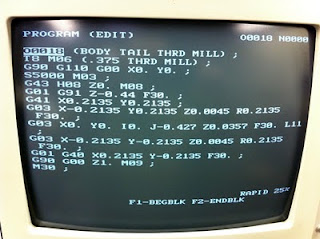Anyway, here is what G-Code looks like. Doesn't make any sense does it?
When I worked on movie props in LA I used to model and machine molds for vacuum forming. Some of those programs had hundreds of thousands of lines...enough to keep the machine busy for six hours or more. There is no way to do that by hand. So, CAM is great for complex 3D surfaces, but for simple geometries I still do it all by hand. You know, old school.
Here is a sample of one of those complex molds. This is the nose panel for one of the Automotive X-Prize cars. Sadly, I think this team has now dropped out. First there is a "roughing pass' that removes the bulk of the material. This started out as one huge block of wood. Then there is a "finishing" pass that refines the surface and brings the part into final tolerance. Here the roughing is complete and the finishing has just started.
The program from the first image cuts the internal threads in the flashlight body, as pictured below. This is a sample part and the first actual part off the machine. More on this later, but I have to make a few parts to work the bugs out of the program.
I digress. Flashlights are very simple, and I'm doing all the coding by hand. I also like coding by hand because I know exactly what the machine is doing, all the time. Software often does some inexplicable things. Sometimes those inexplicable things are really expensive to fix. I'd rather crash the machine due to operator error than software error.




No comments:
Post a Comment